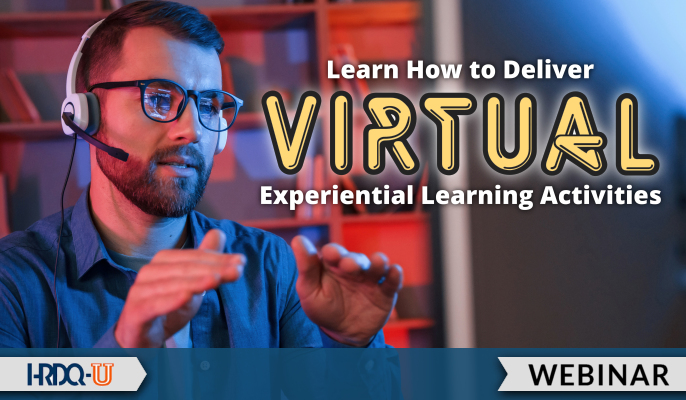- 827 Lincoln Ave. #B-10 West Chester, PA 19380
- support@hrdq.com
- +1-610-279-2002
Quick Links
Menu
Featured Topics
Menu
Total Results
We could not find what you're looking for. Please try again.No Record Found

Would you like to be able to deliver virtual experiential team, leadership, or assessment activities that engage and challenge your participants and drive engagement toward 100%? If so, this webinar will show you how.
Engaging participants online is HARD, but with the right platform, and cleverly designed activities it’s VERY possible.
The webinar will help you answer these questions:
You’ll have the opportunity to observe a virtual experiential session in action and consider and discuss the learning opportunities that the activities generate. You’ll leave the webinar with an understanding of how to run virtual soft-skill workshops without using PowerPoints and without having to deliver content.
If you are interested in using virtual experiential learning activities to develop your participants in areas such as leadership, change, teamwork, communication, negotiation, or problem-solving, then this is the session for you.


Jamie Thompson helps facilitators unleash the power of experiential learning.
Known for his engaging and empowering style and creative approach, over 1000 facilitators and trainers from 37 different countries have attended his train the trainer programs, and they leave his training programs with the tools, skills, and confidence to deliver powerful experiential learning activities.
Jamie has plenty of experience to tap into and share. The MTa experiential learning kits that he and his team have developed are now used in over 100 countries by many of the world’s leading organizations. He has personally designed activities and facilitator training programs for high-profile companies such as Emirates Airlines, Saudi Aramco, Nissan, and Verizon USA. He enjoys sharing his learning and has spoken at conferences throughout the world, including ATD USA, ATD Taiwan, and CIPD London.
Jamie’s creative approach is combined with a rigorous corporate and academic background. He started his career with Deloitte’s Strategy Consulting Practice in 2003 and joined MTa in 2008. In 2016, he won the EU Excellence in Human Resources Scholarship from Leeds University Business School to further his study of organizational behavior and organizational psychology. He’s stayed on at the Business School as a Leader in Residence and guest lecturer and retains an academic interest in team development and facilitation.
MTa Learning has over 35 years of worldwide experience in designing, supplying, and facilitating innovative experiential learning activities, training resources, and people development programs.
Learn more at experientiallearning.org
Training Tools for Developing Great People Skills
This event is sponsored by HRDQ. For 45 years HRDQ has provided research-based, off-the-shelf soft-skills training resources for classroom, virtual, and online training. From assessments and workshops to experiential hands-on games, HRDQ helps organizations improve performance, increase job satisfaction, and more.
Learn more at HRDQstore.com

Sign up to be notified of upcoming live webinars, in-depth workshops, podcasts, blog posts, promotions and much more. Stay ahead of the curve and subscribe for FREE today!